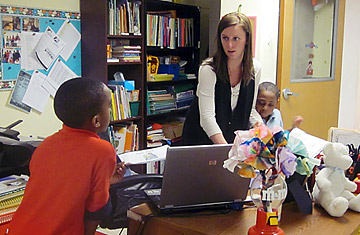
Holly Haralson, a teacher at the Lighthouse Academy in Akron, Ohio, works with first- and second-grade students on Nov. 29, 2011
(2 of 2)
If Lighthouse closes, as expected, it could represent the beginning of a major change in the way charter schools operate. Nationally, charter schools with low scores are only slightly more likely to close than traditional schools with low scores, according to a recent study by the Fordham Institute that examined charters in 10 states. New data released by the Center for Education Reform (CER), a pro-charter group, indicates that 15% of charter schools have been shut down over the course of the charter movement, which began two decades ago. But fewer than 200 of the 6,700 charters that have opened since 1992 were closed down for academic reasons; the majority were shuttered due to financial or mismanagement problems.
Jeanne Allen, CER's president, says administrative problems indicate that a school isn't working long before test scores come out; the center's data, she says, shows that failing schools do get shut down even without the new regulations. "The vast majority succeed [and] stay open," she says. "Those that don't are closed within a few short years before they can ever have any negative impact on students."
Many others within the charter movement, though, are not convinced that closures are always so timely.
The California Charter Schools Association, for instance, is poised to start holding charters to task with or without a new law, and is urging school boards to not allow faltering schools to stay open. Doing so might encourage more school boards to take the politically unpopular step of closing down schools, the group says. Myrna Castrejón, a senior vice president of the association, says her group couldn't keep making the case for charter schools if it was seen as soft on failing charters.
More than almost any other state, Ohio shows that change is possible. The state originally took the "let a thousand flowers bloom" approach, encouraging rapid expansion of charter schools with minimal oversight. Ohio educators expected that parents would stay away from bad charters, which would then be forced to close down, says Todd Ziebarth, vice president of state advocacy and support for the National Alliance for Public Charter Schools.
Instead, the state became something of a national embarrassment in the charter movement, with headlines about gross mismanagement and financial scandals. In 2006, when the automatic closure law was written, more than half of Ohio's charter schools were given a D or F under the state grading system.
The new regulation is a big step forward, but it hasn't fixed everything. Only 17 charters have been shut down in the past five years as a result of the new law, in part because of a loophole that allows high schools with "dropout-prevention programs" to stay open regardless of performance. And more charters have opened to replace those that have been shut down.
Ziebarth thinks closing schools like Lighthouse should be an easy decision. If a school fails to live up to expectations in five years, it should be shut down, he says, adding, "What we can't do is perpetuate mediocrity and failure."
Nonetheless, Lighthouse's Brown and her faculty members think they should have more time to improve before putting their students through the disruption of being sent back to regular public schools, some of which might be worse or only slightly better than Lighthouse. They admit that the school has had a rocky history but say they've replaced the staff in an ongoing effort to improve. "I only wish that Dr. Brown had taken this school on two or three years ago," Cooper says.
For now, it's business as usual for Lighthouse students. On a cold November afternoon, first- and second-graders practiced how to take out books and put them back with the spine facing the right way in the school's brand-new library, then danced to a YouTube video of "Five Little Reindeer Jumping in the Snow."
But the adults in the building can't escape the sadness of impending closure.
Over microwaved pizza and other reheated leftovers in the staff lounge, teachers say they're just trying to get through the school year before thinking about looking for a new job. They worry about what will happen to their children next year in "bigger, rougher" public schools. "The best schools in Akron," says teacher Jessica Satterlee, "are not where our kids live."
Griffin is still hoping that the closing can be averted, but if not, she's sticking to her vow. If Lighthouse shuts down, her daughter still won't be going to an Akron public school. Instead, she will be in private school, which Griffin's extended family will help pay for. "It's hard to explain — as a mother who really, really has a passion for their child's education — I felt so bad. I didn't know what to do," Griffin says. "This school is the only thing she knows."
— With reporting by Emily Alpert / California
This story was produced by The Hechinger Report, a nonprofit, nonpartisan education-news outlet affiliated with Teachers College, Columbia University.
More from The Hechinger Report:
